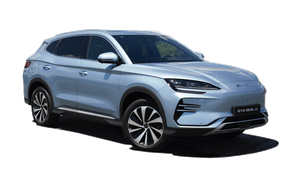Intro and Model History
In the time that the current shape of Mercedes-Benz Vito has been on sale, there have been three generations of Sprinter. It’s a telling fact, proving the importance that the German brand puts on its flagship large van while the smaller model plays second fiddle – to a point, at least.
That’s why the Vito is based on a van body that has now been on the market for over 20 years, albeit with a much sharper and more modern front end and a heavily revised fascia compared with the version that first appeared at the end of 2004. When it made its debut, electric vehicles were little more than an experimental pipe dream – a few niche versions with tiny range figures existed, but the notion of them making full-scale production was considered laughable.
How times have changed – even if the basic Sprinter hasn’t, and nor will it until the end of the 2020s. For now, then, we’ve got a modern powertrain in quite an old van – older, even, than the Peugeot Boxer, Citroen Relay et al, which use a body that came out in 2006.
Until the new Vito arrives towards the end of the decade, the van soldiers on, on the back of a huge facelift to keep it in contention against more modern opposition. Introduced in May 2024, the enhanced Vito is offered in two variants – a 2.0-litre diesel and the fully electric e-Vito. Alongside the panel van, Mercedes-Benz also offers an eight-seater e-Vito, ideal for the taxi and private hire market.
Power is supplied via a 114bhp e-motor, with a 66kWh battery pack that offers a WLTP range of 162 miles, giving a projected urban range a shade under 200 miles and a motorway figure of just half that – it’s far from best-in-class, with the Ford eTransit Custom and VW Transporter claiming 204 miles and the Stellantis mid-sizers (Vauxhall Vivaro, Fiat Scudo, Peugeot Expert and Citroen Dispatch) offering 205 miles, along with the Toyota Proace.
The updated styling gives the Vito a much more modern front end with a deep grille and full LED headlights, plus new bumper designs and LED tail lamps.
There are significant changes inside, too. A new widescreen cockpit with two 12.3-inch displays and a fresh instrument cluster are the key features, as well as a chunky three-spoke steering wheel with hands-off detection warning, plus a centre console that can be equipped with a wireless smartphone charger. There’s also a new generation of Mercedes’s MBUX infotainment and connectivity system.
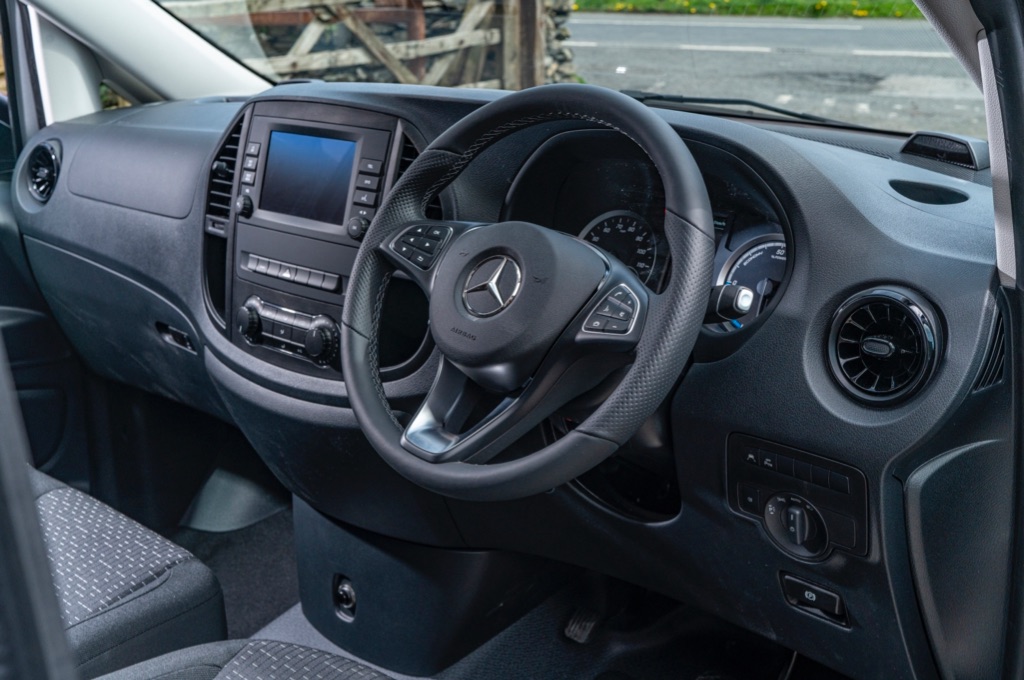
Range, Battery and Charging
There’s just the one battery for now – a 66kWh unit that provides up to 162 miles of range (WLTP). For a medium-sized van, that’s not class-leading, but if you’re using it mostly in an urban environment you can edge that range closer to 200 miles. In reality, that’s where electric vans are at their best anyway, as on faster roads the combination of their weight and the aerodynamic reality of a van body will always limit efficiency.
The new e-Vito is capable of both alternating current (AC) and direct current (DC) charging. On a DC fast charger, you can charge from 10-80% in around 35 minutes, while a home charge using the onboard three-phase charger will take 6-8 hours.
Three driving programmes are offered: Efficiency, Efficiency+ and Comfort, controlling engine power, engine torque and climate control, while there are four regenerative braking settings (D-, D, D+ and D++ for maximum regen).
Practicality, Payload and Dimensions
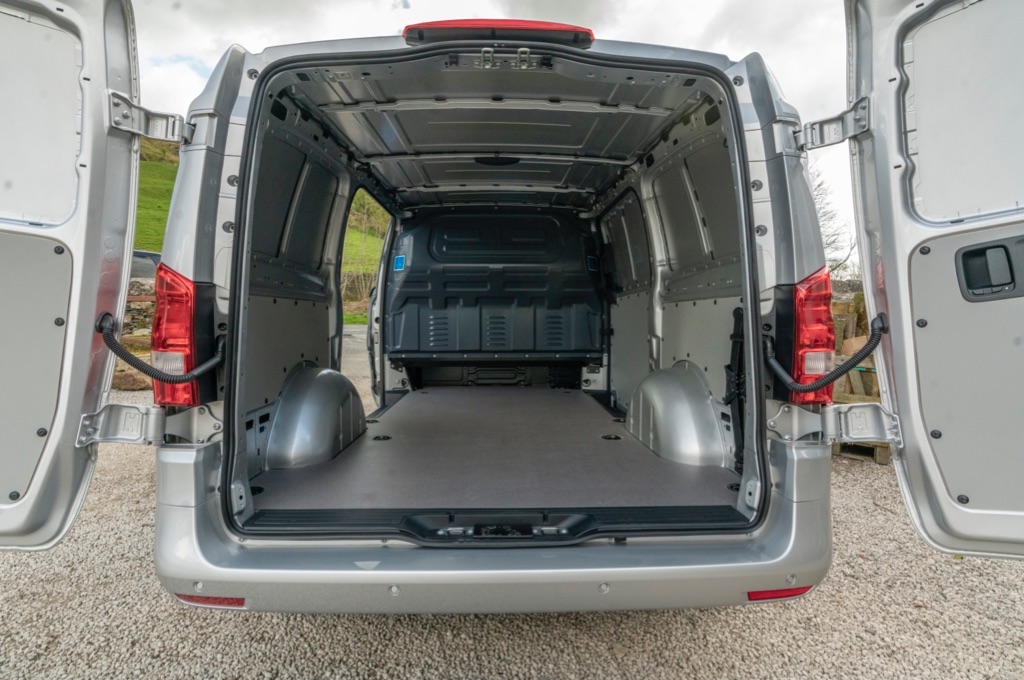
There are two body lengths on offer – L2 and L3, measuring 5140mm and 5370mm respectively. A single roof height is available at 2.0m, meaning it will fit in most garages and multi-storey car parks, though rivals such as the Volkswagen Transporter, Ford eTransit Custom and Stellantis’s mid-size van range are all slightly lower.
Load volumes on the e-Vito range from 5.8 cubic metres to 6.6 cubic metres, with maximum permitted payloads of 824kg for the L2 or 898kg for the L3. There are twin sliding side doors as standard, while access to the rear is via a tailgate or the more traditional split barn doors, both at the same cost.
Inside the load bay, the side panels are protected up to half height with plywood, which can be extended to roof height if buyers require it. A rubberised non-slip floor is offered as an option, along with a neat floor grid that offers multiple lashing points. There is also an optional LED lighting strip for illuminating the bottom part of the load area, to match the lighting above.
Interior, Seating and Technology
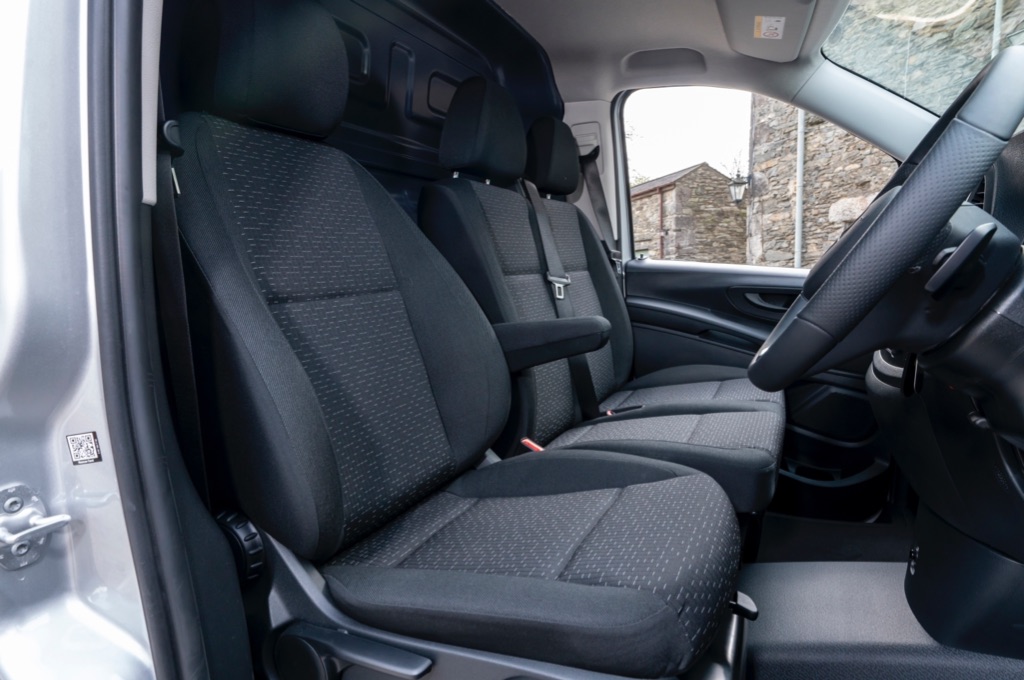
The cabin feels far more advanced than the outgoing model, both in terms of its digital features and also its quality, though there are hints of its age starting to show. The previous model was launched in 2015 and was, itself, an evolution of the 2005 model, so there are some fundamental elements of its architecture whose age is impossible to hide – some of the switchgear, for example, can trace its roots back to the W203 C-Class saloon, introduced in 2000, and it also uses the exterior door handles and lock barrels found on Mercedes passenger cars of two generations back, which underscores the age of the van’s basic design.
Luckily, it was a state-of-the-art van when it launched and it still looks neat and contemporary, especially since the cabin was given a thorough rework as part of the 2024 facelift.
It's ergonomically well laid-out, with the brand’s trademark three-spoke multifunction steering wheel, which feels reassuringly chunky, while the latest MBUX infotainment set-up is excellent, the seats are extremely comfortable and the driving position highly adjustable and affording good all-round visibility.
The new generation of the MBUX multimedia system comes with a 10.25-inch colour display, telediagnostics and maintenance management, accident recovery and roadside assistance, remote vehicle locking and unlocking and pre-entry climate control, all operable via a connected app. It’s somewhat at odds with the primary switchgear, though – some of which feels clunky and old-fashioned.
The e-Vito’s climate control system has a heat pump, heated seats and active thermal management to maximise the range in cold conditions, while driver assistance and safety features include ATTENTION ASSIST drowsiness warning, Intelligent Speed Assist with cruise control, Active Brake Assist, Active Lane Keeping Assist, Blind Spot Assist, Mercedes-Benz emergency call system and a reversing camera.
Motors, Performance and Handling
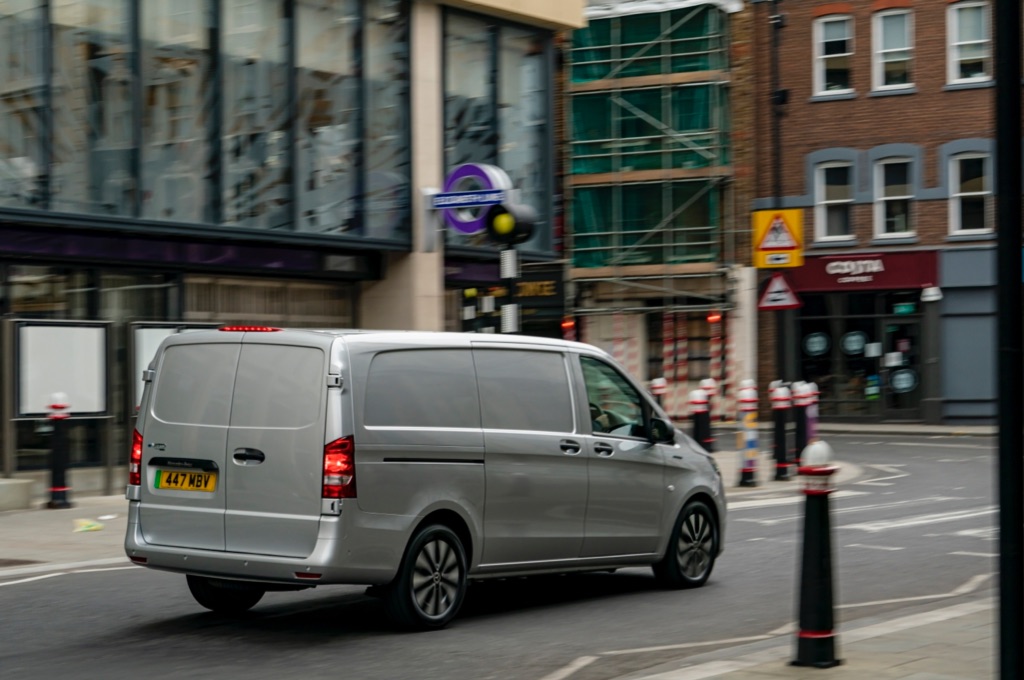
Despite being based on aged architecture, the e-Vito acquits itself well on the road with well-weighted steering and good ride quality – it’s not as sharp or as smooth as the Ford eTransit Custom, but the gulf between the two certainly doesn’t feel two decades old and it remains composed and comfortable both laden and unladen. It’s genuinely fun to drive.
Visibility is good, while work carried out by Mercedes on door and window seals as part of the 2024 facelift has made a massive difference to noise levels and refinement.
You select Drive using a column stalk that’s where the wipers are in most rivals – which can be confusing for fleet drivers hopping from van to van, but otherwise it’s as simple as any EV to drive, and the 114bhp motor feels lively enough, if not exactly punchy.
There are three selectable driving modes – Comfort, Efficiency and Efficiency+ – and you can also adjust the level of regenerative braking via the steering-wheel-mounted paddles. There are four modes - D-, D, D+ and D++. In D- you can slow the van to walking pace without touching the brake. If you don’t want to use the models manually then there is a new mode, called D Auto, which automatically adjusts the amount of regenerative braking to suit road conditions.
The reversing camera is among the best-in-class, with a better field of vision and greater accuracy when parking and manoeuvring than rival systems – ideal if you need to squeeze it into a tight driveway or garage.
The only area where it appears genuinely dated is in some of the switchgear, which feels clunky and old-fashioned – or if you prefer, chunky and functional. Some van users will prefer the simplicity and mechanical feel of it to the softer, more digital controls or touchscreen sliders in later vans.
Running costs, Pricing and Specs
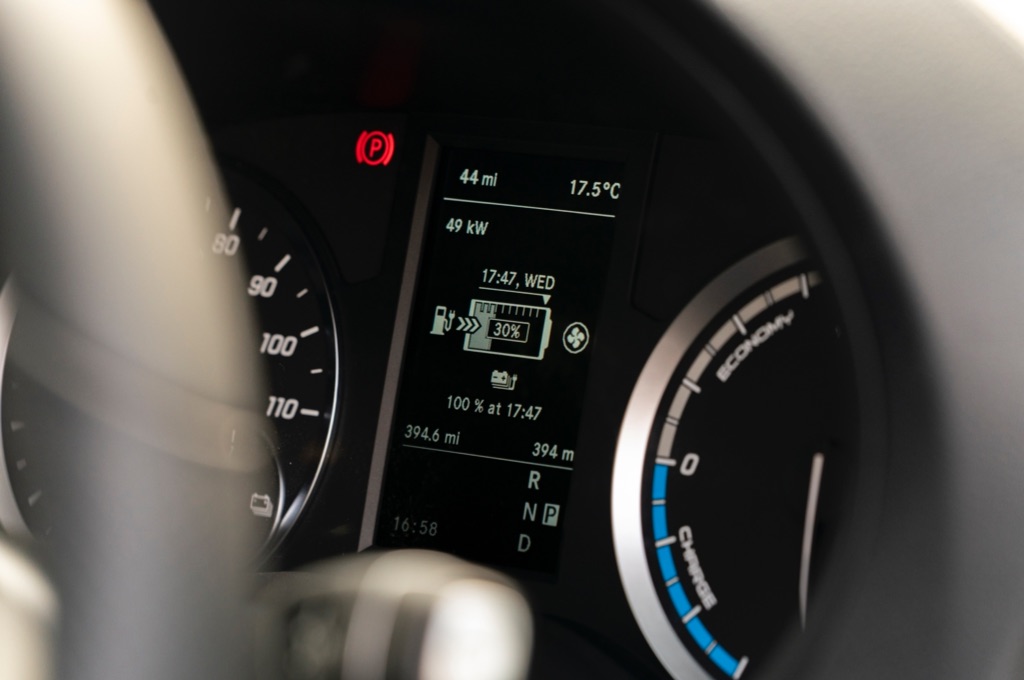
The e-Vito comes in two trim levels – the business-like PRO and the plusher SELECT – both of which come with a suite of driver assistance systems including Active Brake Assist, ATTENTION Assist, Headlight Assist including rain sensor, DISTRONIC Active Distance Assist, Blind Spot Assist, Active Lane Keeping Assist, Intelligent Speed Assist and a PARKTRONIC parking package as standard.
SELECT models get body-coloured bumpers and a plusher trim, a more advanced version of MBUX, keyless entry and adaptive MULTIBEAM LED headlights with High-beam Assist, plus a 360-degree camera and keyless entry, plus TEMPMATIC air conditioning. The boffins at Mercedes love their uppercase letters, that’s for sure.
Prices start at £48,530 (ex VAT and PiVG) for the PRO and £51,915 (ex VAT and PiVG) for the SELECT – while passenger models begin at £64,135 (ex VAT) and are only eligible for the Plug-in Van Grant if classed as a minibus, not a passenger car.
All Mercedes e-Vitos come with an integrated service package (ISP) as standard, which covers the costs of two minor and two major services within the first four years, along with free, Europe-wide roadside assistance, including out-of-charge cover, for up to 30 years, as well as a three-year unlimited mileage warranty and an eight-year/100,000-mile battery capacity guarantee, extendable to 200,000 miles.
Verdict
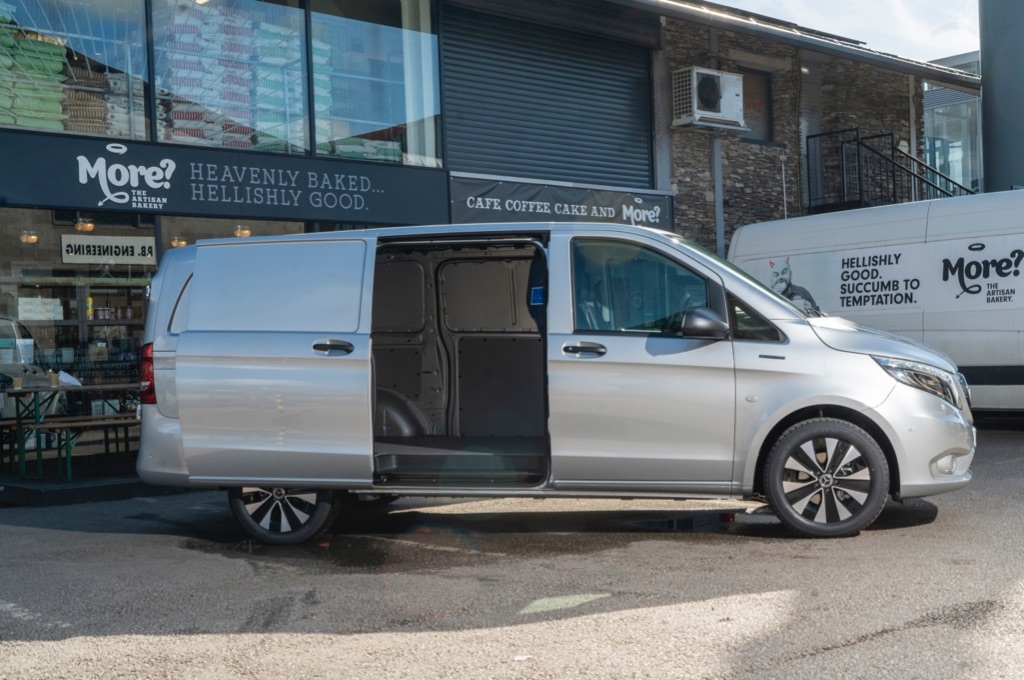
The latest version of the Mercedes-Benz e-Vito is a stylish van with a premium image and for many buyers that will be enough, as in pricing terms it sits pretty close to the Volkswagen Transporter Electric and Ford eTransit Custom. It comes down to whether or not you want the more modern cabin features and longer range of its rivals over the cachet of one of the most prestigious and proven brands in the commercial vehicle (and, indeed, automotive) world.
More modern rivals are sharper and more sophisticated, and they’ll go further on a single charge. But if that doesn’t bother you, then the e-Vito is the choice for small business owners who place a strong value on image – it’s a well-made van with a prestigious reputation.


























